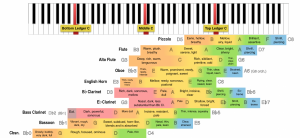Let me know what you think...who else would love to have hundreds of these to hand, from dozens of very different composers, in a concise, browsable format?
First of all, those who know me a bit longer in this forum know my opinion about shortcuts in learning, so i will restrain myself a bit. (of course not without repeating once more that beyond the very basics instrumentation is much more about the ability to write appropriate textures for the respective function of the specific instruments). – i also think that the outcome of your project may be helpful/inspirational for some.
However, i think it's necessary to point out, that your very first example – The Esterházy – is a bit flawed without further additions.
The problem lies within the instrument of the Oboe.
Nowadays, almost every orchestra outside of Vienna uses the french oboe, while the music of the Viennese classic used the Viennese oboe.
To people with some sensible ears the difference between those instruments is quite big.
The french (or "usual") oboe has a much stronger formant in the sensible "a" area and therefore cuts extremely well through an arrangement.
On the downside, the sound of the oboe gets fatiguing quite soon.
(if you check scores by good orchestrators you will see that they all pay attention to this. Or the other way round: you can often spot the not-so-good orchestrator by the overuse of the oboe).
Now, the composers of the viennese classic very clearly had the sound of the viennese oboe in mind, which is much more decent in context. If you're familiar with that sound you will understand that this typical instrumentation does indeed not rely on the "oboe" but on the "viennese oboe".
Finally, since you're aiming at composers with virtual instruments, let me add that there is in fact a viennese oboe available as a sampled instrument.
It's part of the fantastic VSL woodwinds.
Besides that, i wish you a lot of success with your upcoming channel!






